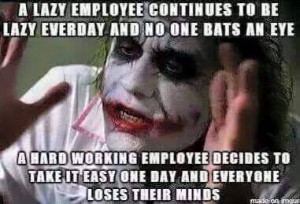The downside of being a retail ‘manager’

Family Dollar’s managers have sued for the right to overtime, and mostly lost. (AP Photo/Eric Gay, File)
Most days, the manager arrives at a Stop-n-Go convenience store in Madison, Wis., at 7 a.m. But at previous locations — and even now, if his opener calls in sick – he has to be there at 4:30 a.m. to unlock the glass door, put the coffee on, make sure the cups and creamers are stocked and arrange the doughnuts in their case. He sets up the roller grill with breakfast foods, wipes down the windows and the soda machines, scans in the newspapers and makes sure the bathrooms are clean.
The store opens at 5 a.m., and the manager starts ringing the cash register and setting up pre-pays at the gas pumps. His actual managerial duties don’t begin until mid-morning, when he starts filling in spreadsheets on a computer, making sure all the transactions and cash drops balance out.
Vendors arrive to be checked in. Job applicants arrive for interviews, to replace the employees who leave when they find jobs that pay more than $8 an hour. Then there’s the Book, where the manager takes down all his employees’ discounts and voids, temperature checks on the freezers, and everything else having to do with the running of a retail establishment that stays open 18 hours a day.
All the while, though, he’s on call for help with cashiering, stocking shelves, changing prices, or mopping floors. On paper, he leaves at about 4 p.m., but that often extends until 6 p.m., with only an occasional day completely free.
“For the last few months, I’ve been getting Sundays off. That’s like a reward or something,” says the manager, who asked for anonymity for fear of retaliation by his employer (he dislikes the job but fears he couldn’t get a better one if he lost it).
Stop-n-Go, a family-owned, 50-year-old, 36-store chain in Wisconsin and Illinois, did not respond to multiple calls or e-mails for comment.
“You start out with two weeks of vacation, but they can’t staff for it,” the manager says. “Actually, when I’m not here, I’m managing the store. If there’s a question, five in the morning to 10 at night, I’m here.” That comes out to about 55 hours a week, and sometimes more on short notice, for which the manager — a single dad — has missed all manner of family events.
After several years on the job, the manager makes around $700 a week, which comes to the mid-$30,000s a year before taxes, plus the occasional bonus for high sales or low waste (that’s lower than the mean annual wage for retail managers,which is $41,450). And never, not once, has he been paid overtime — usually considered a low-wage employee’s due for working more than 40 hours a week.
That can’t be right, the manager thought. He took the matter to a local law firm, Hawks Quindel. They were initially interested in taking the case — but after reviewing all the facts, they concluded that it probably wouldn’t stand up in court. Under the Fair Labor Standards Act’s “executive” exemption, which depends on a number of factors, salaried workers who supervise two or more employees usually aren’t eligible for time and a half.
“This is a pay practice that everybody uses,” says attorney David Zoeller, who looked at the manager’s situation. “They’ve all taken advantage of what the regulations are. They set low salaries, and they don’t pay overtime.”
That wasn’t always how things worked. As originally written in the 1940s, the Fair Labor Standards Act limited the percentage of the day that an employee could spend on non-managerial duties and still be exempt from overtime, which over the years came to be understood as no more than 50 percent.
But in 2004, President George W. Bush’s Department of Labor overhauled the rules, which accomplished two things: First, it raised the salary threshold below which all workers are entitled to overtime, from $250 per week to $455 per week. And second, it reorganized all the exemptions in such a way that more employees wouldn’t qualify because of what they did on the job. Under the new rules, people could be defined as managers exempt from overtime, for example, while doing grunt work and supervisory work simultaneously.
Labor groups denounced the changes, and employers cheered. Over the past decade, the executive exemption has been extensively litigated — often in casesagainst discount retail empires such as Dollar General and Family Dollar — andusually decided in favor of the employer. (Some plaintiffs have been more successful; Starbucks has settled a number of overtime cases out of court.)
“That was a project to relieve as many employers as possible of their obligation to pay overtime,” says Ross Eisenbrey, vice president of the Economic Policy Institute, which receives some funding from unions. “So they started out with something that was worse than where it ended up, but they did a lot of damage.”
Halfway through his second term, President Obama decided to swing the pendulum back toward workers. In March, Secretary of Labor Tom Perez signaled that he planned to raise that salary threshold much higher, and over the summer held listening sessions with both workers and employers. He didn’t give an estimate of where it should end up, but labor advocates have some ideas.
According to an analysis by EPI, 65 percent of all salaried workers fell under the threshold in 1975, and were thus entitled to overtime. By 2013, just 11 percent of salaried workers were automatically due overtime pay, leaving the rest subject to a host of exemptions. EPI proposes raising the cutoff to $984 a week, or about $50,000 a year, which is simply what it was back in 1975, adjusted for inflation.
“If you raise the salary threshold high enough, then you catch everybody whose financial situation you really worry about,” Eisenbrey explains. That could includemillions of white-collar workers in clerical and administrative roles, as well as low-level managers.
“WE ARE THE RAINMAKERS FOR THE COMPANY, BECAUSE NO MATTER WHAT HAPPENS, THE MANAGER HAS TO WORK.”
To employers, entitling millions more employees to overtime is terrifying.
“The concern of this community, retail and restaurants in particular, is how high is that going to go,” says Tammy McCutchen, the Bush-era Labor Department official who oversaw the changes in 2004 and now represents the U.S. Chamber of Commerce for the global law firm Littler Mendelson. “Managers at restaurants and retail do not make $50,000 per year. Hardly anyone in the country does. There will be a substantial number of retailers or restaurants who will have to reclassify people as hourly.”
The Obama administration has also said it plans to reexamine the executive exemption. McCutchen thinks that could mean putting it back to how it was before 2004 — which is still the case in California — making it more difficult to deny overtime to managers. That has irked the National Retail Federation, which put its members on high alert in early September, anticipating that proposed changes would come out sometime in November.
“Having a manager who is only supervising takes away from the customer service goal,” says NRF’s senior vice president for government relations, David French. “You need a manger who has flexibility. That’s the reality of the way the retail workspace is. We look at that, and we’re very concerned, because that amount of change might force some of our members to rethink their business model.”
The manager in Madison, though, thinks a new business model might be just what’s needed. Doing a regular employee’s work and a supervisor’s work can get stressful.
“I think a 911 operator would be a walk in the park, to be honest with you,” he says. “Because no one task is that difficult. But when you roll them all together, and have me wash the toilets and stock the shelves in addition, it’s overwhelming.”
Especially, of course, without earning any more for all the extra time.
“Ringing the register is so part of my job that I have to work more than my salaried 48 to finish my job for free,” the manager says. “We are the rainmakers for the company, because no matter what happens, the manager has to work.”
Sourced from washingtonpost.com























Recent Comments